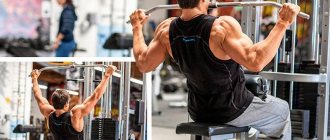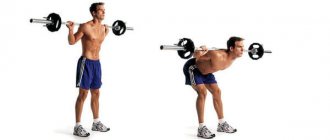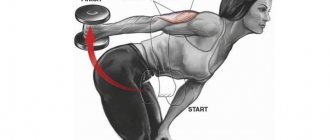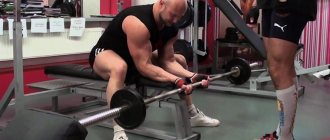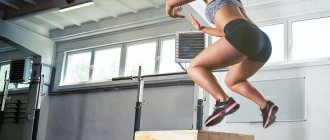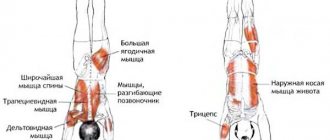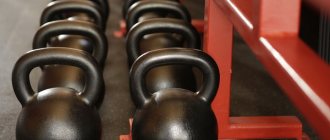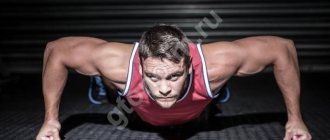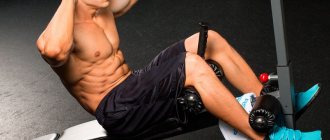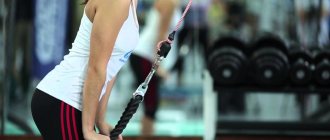Strong back muscles are not only a beautiful figure, but also a guarantee of good health. Developed muscles help keep the body upright and reduce the overall load on the spine.
One of the main exercises for strengthening the back muscles in girls is the horizontal pull-down. It does not load the lower back and allows women with an initial level of training to fully train.
Horizontal block thrust target
The horizontal pull-down is an athletic exercise that allows you to achieve the following goals:
- Increased strength and endurance of the back muscles. The lat pulldown in the simulator is a complete basic exercise. During its execution, movement occurs in 2 paired joints (elbow and shoulder). A convenient location on the machine bench relieves stress from the lower back and allows you to use large working weights.
- Rehabilitation and recovery. Sports activities using a horizontal block isolate the upper body. In contrast to bent over rows of barbells or dumbbells, the load on the lumbar spine is significantly reduced. When exercising with a block simulator, it becomes possible to better control the weight of the weight and concentrate on muscle contraction. This makes it possible to continue training even with minor sprains and injuries.
- Giving depth and definition to the back muscles . Due to the hormonal characteristics of the female body, it is impossible to build large muscle volumes in girls without the use of special means. Therefore, building the depth of the muscles of the back of the body is one of the few ways to create the appearance of a harmoniously developed and strong back.
Horizontal block row to the abdomen - working muscles
When performing horizontal block rows, the following large and small muscle groups are involved in the work:
| Name | What role do they play? |
| Latissimus dorsi muscle | These paired muscles bear the main load. The latissimus dorsi muscles are responsible for abducting the arm beyond the plane of the body and bringing it to the sides. |
| Rhomboid muscles | Internal back muscles. Located in the upper third of the body. This paired muscle group is shaped like a diamond and is located under the trapezius muscles. The main task of this group is to bring the shoulder blades together. |
| Trapezius muscles | They belong to the group of postural muscles. They are responsible for maintaining the correct position of the spine and for the correct location of the shoulder joint. The trapezius is located symmetrically along the spine. |
| Rear delts | Participate in abduction of the arm beyond the line of the body and transverse adduction of the shoulder. The arm is also bent at the elbow joint. |
| Teres major muscles of the back | Paired muscles located above the latissimus in the upper back. Responsible for moving the chest up and forward. They have a postural nature and help to form correct and healthy posture. |
| Long back extensors | The muscles are located in the lower back and are located symmetrically along the spine. |
To effectively train all of these muscle groups, girls need to follow a number of recommendations:
- To engage the muscles responsible for the correct position of the spine and posture, it is necessary to bring the shoulder blades together as fully as possible and move the elbows back. In this case, the trapezius and rhomboid muscles of the back receive sufficient incentives to grow and strengthen.
- All athletic movements in the gym must be performed smoothly. This is especially true for training with block simulators and horizontal rows in particular.
- Watch the position of your legs. The lower limbs should be securely fixed and slightly bent at the knee joint. Straight legs will cause excessive tension in the hamstrings. In this case, performing the exercise will become uncomfortable. Excessively bent lower limbs will interfere with the movement of the machine handle.
- Body rocking. Girls should not resort to this technique. Thanks to swinging, it becomes possible to operate with large working weights. This is not required to build a harmoniously developed back.
- Elbow position. The practitioner's hands should move along the body. They should not be moved to the sides when pulling a horizontal block. This will reduce the effectiveness of the exercise.
The horizontal block row requires compliance with the rules of technique for performing the exercise. Rocking the body or rounding the thoracic spine can lead to injury. Such disorders prevent the back muscles from performing their functions. The load is transferred to other muscles (extensors and biceps).
Correct technique
The pull is performed as follows:
The ideal technique involves maintaining a straight back at the end point of the pull.
- take the starting position - sit on the bench in front of the machine, grab the handle, pulling it towards you, place your feet on the supports, slightly bending them at the knees, the body should be vertical or slightly tilted back;
- As you inhale, straighten your arms forward, while slightly moving your body forward;
- as you exhale, bend your arms and pull the handle towards you (different options involve touching the handle to the body at different levels - from the chest to the navel), returning to the starting position and feeling how the back muscles work;
- do the required number of repetitions.
For high-intensity workouts, rest between sets can be half a minute; if you train with heavy weights, the time needs to be increased.
The horizontal pull-down can also be combined in supersets with other back exercises - in this case, the lats will grow at the maximum rate. When performing deadlifts with a wide grip, the handle should be pulled towards the chest, and if a wide grip is used, the hands should go to the stomach.
In both variants, it is necessary to actively work with your back, while bending your arms, moving your shoulders back as far as possible and bringing your shoulder blades together.
Common Mistakes
Uncontrolled rocking of the back will reduce the load on the latissimus muscles
- Excessive body rocking back and forth
Beginners who are just learning this exercise often begin to swing violently back and forth, thereby taking the load off the target muscles.
When extending your arms, you need to move forward a little, and during the reverse movement, pull them back to a vertical position or a little further.
The amplitude of body movements should be small; under no circumstances should you lean your body too far back.
When working with large weights, it can be increased, but even in this case it is necessary to observe the measure.
- Leg extension and flexion
During the final stage of the deadlift, many people help themselves with their legs, extending them. This should not be done: the pelvis should be in one place throughout the entire approach, this will allow maximum load on the back.
There are many other exercises for working your legs.
- Elbow extension to the sides
When performing the exercise, your elbows should be down, they should not be spread far to the sides. This rule is especially true for close-grip deadlifts.
If you spread your elbows wide to the sides, you won’t be able to effectively work out the target muscles, which means you shouldn’t expect good results from your training.
How to choose the weight?
Considering that this exercise is isolating, there is no point in doing it for weight. So forget about maximizing weights and doing 4-6 reps. The optimal would be 10-14 times in a leisurely technique, filling the muscles with blood as much as possible. The last repetitions can be done with cheating to “squeeze” all the strength from the back muscles.
How to add to a training program?
Since this exercise is not basic, it should be included at the end of the workout to work out already tired latissimus muscles. Some experienced athletes add deadlifts at the beginning of the session to warm up the back and pump more blood into it before pumping training.
Weight selection
Incorrect choice of weight value when performing lower pulley rows can lead to:
- To muscle injury or spinal damage. This happens when using excessive loads. A girl or woman miscalculates the forces and places too much weight on the sports equipment. A characteristic sign of such an error is a violation of the technique of performing an athletic movement. The body begins to sway and the back begins to round.
- Lack of progress in training. A small weight of weight is not able to load the muscles and create the preconditions for growth. As a result, the girl does not get the desired result and is disappointed in the exercise.
In order for the horizontal pull-down to give the maximum effect from training, it is necessary to select the correct amount of weight.
To correctly determine the amount of load, you should be guided by the following rule: exercises in bodybuilding and fitness are not performed to the limit of a person’s physiological capabilities. The main principle of training is maintaining the correct technique.
When performing lat pulldowns, only the last 3-4 reps of the set should be heavy.
Therefore, the correct load is considered to be such that it is possible to perform a given number of repetitions with the correct technique, and the last 3 repetitions of each approach cause a slight burning sensation in the muscles.
You can determine what weight is appropriate as follows:
- Set an arbitrary weight and perform 5-7 repetitions. If you can do this easily, then add 2.5 kg.
- Perform 4-5 more reps and add weight if necessary.
- Repeat this algorithm until 3-5 repetitions begin to be difficult.
- Rest for 2-4 minutes and try to complete 12-15 repetitions.
Grip options
The back is one of the largest muscle groups in the human body. Therefore, it is difficult to choose a universal exercise that would equally involve all the muscles of the back surface of the body. Even the horizontal block pull has a different effect on the working muscles depending on the grip width and the position of the hands on the handle of the machine.
Wide way
It is obtained by using the long crossbar of a vertical block as a handle. In this case, the hands on it can be in a state of pronation (turned palms down) and supination (turned palms up). During the exercise, with your arms placed wide on the crossbar of the machine, the outer parts of the latissimus dorsi muscles are used.
At the initial point of the trajectory, the shoulders move forward further and, when pulling the block towards you, maximum contraction of the muscles of the outer back occurs. If the hands are turned palms down, then the upper parts of the lats are involved in the work. If the palms of the hands are turned upward (supinated), then the lower part of these muscles is used to a greater extent.
Narrow way
A narrow grip is achieved through the use of a short double V-shaped handle. In this case, the hands are parallel to each other, and the thumbs are directed upward. When performing horizontal rows in this way, the trapezius, rhomboids, and inner part of the latissimus muscles are included in the work.
When training with a narrow arm position, it is important to pay great attention to bringing the shoulder blades together. Otherwise, using a short crossbar makes no sense. The main attention is paid to the completeness of the amplitude of contraction of the trapezius muscles.
Exercise options
Variations vary depending on the features of the machine, handlebar and seat height. This same row can be done on a lever machine or in a humvee machine to provide sufficient resistance.
Options depending on grip
- When pulling with a narrow grip with palms aligned, a good stretch is created in the center of the back and the latissimus muscles. This version of the exercise allows you to work out the so-called “depth” of the back and give relief to the center of the lats.
- The deadlift option with the arms placed wide and palms inward with the forearm perpendicular to the floor allows you to additionally use not only the top of the latissimus, but also the posterior bundles of the deltoid muscles. This contributes to the formation of a beautiful, T-shaped back.
- If you point your palms inward and leave your grip wide, or grab a curved bar with your hands for deadlifts, the exercise will turn into a real “sculptor” for the contours of your back, and will allow you to form a beautiful relief along with the design of your lats.
Pull in different directions
A simple principle applies here: to which part of the body we perform deadlifts, the muscles there are used more. To work on the middle part of the back, you need to pull towards the belt, the waist line, and try to make the movement using the back muscles. The pull towards the groin helps shape the lower segment of the latissimus, and towards the chest – the upper. For beginners, it is more convenient to pull towards the chest, since their center of the back often lags behind. You can alternate the direction of the pull from workout to workout to develop your back harmoniously.
Traction for girls
This exercise is often included in women's workouts, which is completely justified. Most girls do not want to have a significant mass of back muscles, and are content with a slight correction of posture and toning. The movement helps activate the lats, removes unsightly “waves” on the back that appear with insufficient muscle tone, and allows you to get rid of pain. In women's training, this may be the only horizontal row if the goal is solely to lose weight and maintain muscle tone.
Pull in different directions
Traction can be performed in several main directions:
- To the lower abdomen. With this option, the back muscles are included in the work. The main emphasis of the load shifts towards the bottom of the lats. Also, a significant part of the load falls on the posterior bundle of deltoid muscles. This occurs due to the greater range of motion of the elbow. The hand goes further beyond the line of the body. At the same time, the rear delta contracts and stretches more intensely.
- To the chest. The deadlift engages the muscles of the entire back of the body. The main load is distributed between the large round muscles and the top of the latissimus. Depending on the selected grip width and type of handle, both the rhomboid and trapezius muscles can be involved in the work. The rear delts work to a lesser extent.
- To the head. This version of the exercise is performed sitting or standing in a crossover. All muscles of the upper back are involved. The pull of the horizontal block to the head allows the shoulder joint to perform external rotation. This strengthens the internal rotator cuff.
Main muscles involved in the exercise
The main load falls on the latissimus dorsi muscles, which is why many people confuse pulley rows with rowing. This is a misconception - rowing and the cable machine have different goals. Do not try to imitate rowing movements on the simulator - you will not get the benefits and the required load. Here is a complete list of muscle groups that will be pumped:
- lats;
- large diamond-shaped;
- trapezoidal;
- spinal extensors.
On a note! For women and girls, block traction is excellent in rehabilitation programs. The only caveat is that you should refuse to use a belt if the exercise is performed while sitting.
When not to deadlift
The horizontal pull-down is a relatively safe exercise. Despite the fact that in the process of performing it all the muscles of the posterior upper surface of the body are involved, and the movement is carried out in several paired joints at once, the risk of injury is minimal.
The lat pulldown is often practiced for minor injuries in the target muscle group. Light loads and the ability to use individual bundles of back muscles in isolation make it possible to use this exercise as a restorative and preparatory set of movements for the start of sports activities after injuries.
However, there are a number of contraindications in which you should not perform deadlifts. These include spinal injuries, shoulder dislocations and subluxations, and muscle ruptures in the upper half of the body.
The training is contraindicated for all girls and women who are not allowed by the attending physician to exercise in the gym.
Parallel grip exercise
Also a very popular variation of the horizontal block row to the stomach is the parallel grip row. According to training men and women, this version of the bench press allows you to work out the required muscles particularly effectively. To perform this exercise, you should install a handle with two handles on the simulator, which you should then grab in such a way that your hands are clenched in fists and your thumb is on top. The rest of the equipment is almost completely identical to the standard one. You need to sit on the machine, setting your weight. Also tilt your body forward, and as you exhale, lean back, while simultaneously pulling your arms towards your stomach. As soon as your hands touch this part of the body, you should freeze for a couple of seconds, then inhale and slowly return to the starting position. We perform the exercise in this way the selected number of times.
Technique for performing exercises with a horizontal block while sitting and standing for girls
Gym classes for girls differ from similar workouts for men only in the amount of weight used and the number of approaches and repetitions.
The functions and places of muscle attachment in women and men are identical. Therefore, the technique of performing exercises using a horizontal block described below is relevant for both the former and the latter.
Belt pull
The lower block is pulled to the belt using a short double V-shaped handle. The movement is performed with a narrow grip. Before starting your workout, you need to warm up properly. For this purpose, joint gymnastics is used.
After warming up, you should take the starting position:
- The back should be brought to the vertical and slightly laid back.
- The lower limbs are bent at the knee joint. The feet rest on the bolsters or platform of the machine.
- Shoulders lean forward slightly, arms extended.
- Look ahead.
The movement is performed smoothly, without jerking. Girls should not resort to swinging their body when pulling the block towards themselves. The spine should be in a static position. The weight is pulled by contracting the back muscles. It is important to continue the movement until the handle touches the body.
Cravings to the stomach
Pulling a horizontal block to the stomach can be done either using a narrow handle or a long crossbar with a wide stance of the arms. When performing this type of exercise, you should completely repeat the starting position occupied when pulling the lower block to the belt.
The main feature of the block pull to the stomach is the abduction of the elbows from the body at an angle of 15 to 30 degrees. The emphasis of the load shifts to the outer part of the back. The waist row intensely engages the lower and middle portions of the lats.
Back row
When performing this type of exercise, a cable handle or crossover handle is used.
The starting position is completely identical to the 2nd previous version of the lower block thrust.
The main difference between the back pull is that this movement is carried out by each hand alternately.
First, the girl or woman should grab the handle with one hand and pull down on the stomach the required number of times.
Then there is a change of hands. The free hand can be placed on the belt. This will help keep your body straight.
The advantage of this type of horizontal pull-down is the ability to maximize the range of motion and train each half of the back muscles separately.
In order to increase the amplitude when pulling the block to the stomach, it is necessary not to stop when the handle touches the body, but to continue moving further , moving the hand behind the plane of the back. In this case, slight rotation of the body is allowed. Asymmetrical training of paired muscles is necessary to eliminate imbalances in their development.
Craving for the head
The head pull-down is used to train the rotator cuff, posterior deltoid, and upper back muscles. In particular, the trapezius and rhomboid muscles. The exercise can be performed while sitting in a machine or standing using a crossover. The latter option is preferable, since it is easier to maintain balance in this case.
To pull a horizontal block to the head, use a cable handle or any other flexible connection, such as a chain.
The starting position looks like this:
- Place the block in the crossover at forehead level.
- Approach the machine and grab the ends of the cable with both hands. In this case, the thumbs should point towards the practitioner.
- Take 1.5-2 steps back.
- Raise your arms to forehead level and begin deadlifting.
The “pull-up” movement continues until the hands of the woman working out in the gym are at the same level as her ears.
Crossover triceps row
To perform triceps pull-downs, you will need a crossover machine and a bench with an adjustable backrest:
- It is necessary to position the bench in the plane of the simulator so that the adjustable part is directed towards the working block and handle.
- Raise the back of the bench by 40-45 degrees (the angle between the floor and the back).
- Place a short straight handle on the pulley cable.
- Grab the handle of the machine and lie down on the bench.
- Raise your arms vertically up.
From the indicated position, you should begin lowering the handle of the exercise machine down behind your head. In this case, the arms should bend and the elbows should remain motionless. The exercise is analogous to the classic French barbell press. Therefore, all recommendations regarding this athletic movement also apply to the triceps pulldown in the crossover.
Thrust to the chest
The horizontal pull-down to the chest is performed using a long horizontal bar. The starting position is identical to the position when moving to the lower abdomen and waist.
The key difference is the working muscles. In this embodiment, the main emphasis of the load is shifted towards the top of the lats.
Pulldown of the lower block to the chest
What muscles work when placing your arms wide and pulling to the chest?
A version of the horizontal block pull-down on the shoulders is performed to the chest with a wide grip. This ensures the development and shifting of the load on the following muscles:
- Posterior deltoids.
- Lat.
- The big and small ones are round.
- All parts of trapezoids.
- Infraspinatus.
The main emphasis shifts to the trapezius and rear deltas.
Technique for performing horizontal block rows to the chest for the shoulders
The technique of pulling the lower block to the chest is almost no different from the classic version, with the exception of the angle and width of the grip.
Peculiarities:
- Take a position with your knees bent on the platforms. Take the long handle where it bends (this is anatomically more convenient, although if such a handle is not available, you can use the usual straight version).
- Start pulling the handle towards your lower chest. Elbows should point to the sides so that your arms are parallel to the floor.
- At the peak point, squeeze your shoulder blades together as much as possible and pause for 0.5-1 second.
Recommendations
The first rule that should be remembered when performing lower block rows to the chest is that despite the similarity of the movement, you cannot use a lot of weight in this exercise. If in the usual version you can take the maximum possible weight with which you can perform the movement without distorting the technique, then when focusing on the rear deltoids and trapezius, this approach is not only ineffective, but also dangerous.
It is much more effective in this type to work with moderate weight, at a slow pace and in a high-repetition mode (12-15 repetitions). Approaches with a weight of 40-50% of 1RM to failure also work well.
Another difference between the traction of a horizontal block to the chest is the abduction of the body. If, when working on the lats, the body can be swayed up to 10 degrees (to provide additional stretching), then in this option a strong deviation should not be made. The body must be securely fixed, eliminating any swinging and inertia.
How to Add Deadlifts to Your Training Program
The horizontal block row can be used by girls and women as a main exercise for the back of the body. The lower block row is also used for additional fatigue of the back muscles after heavy basic movements with free weights. In this case, you should reduce the amount of weight and increase the number of repetitions performed in each approach.
Thus, the horizontal block row can be added either at the beginning of the training program or in the middle. The only condition is that this exercise must be performed on the day of back muscle training.
Content
- 1 Purpose of the exercise
- 2 How to do the exercise correctly
- 3 Common mistakes and recommendations
- 4 Working muscles
- 5 Technique 5.1 Horizontal abdominal row with 2 arms in a block simulator
- 5.2 1 arm row
- 5.3 Rows on a lever machine
Pulling a block to the abdomen on a simulator
Pulling a block to the abdomen on a simulator
The horizontal block row to the stomach on the machine is an exercise for the back. It is performed in two technical versions, the choice depends on the type of simulator and the purpose of the exercise. It is used both in training for beginners to learn deadlifts, and in training for more experienced athletes. Often used to correct muscle imbalances.
Basic runtime errors
Despite the simplicity of the technique of performing thrusts towards the body, many girls and women make a number of mistakes during training. This is due to a lack of experience in sports and the lack of basic theoretical training in anatomy and physiology.
Main mistakes:
- Rounding the back. Too much weight leads to the fact that the girl is not able to control the sports equipment. The body begins to round and a traumatic situation arises.
- Lowering the chin down . Girls and women look down, trying to control the trajectory of the handle. However, this relaxes the neck muscles and increases the risk of pulling them.
- Involvement of non-target muscles. Pulling a block with your hands, rocking your body, and pushing off the platform of the exercise machine with your feet are the most common mistakes. Allowing such violations of technology is strictly prohibited.
Training mistakes
Instructors who monitor the performance of horizontal pull-downs by men and women in the gym note that many of them make mistakes during the training process. But avoiding these mistakes is as easy as shelling pears if you remember the correct technique while performing the exercise.
- You cannot round your back or hunch over - the spine should always be completely straight, “on line.”
- You should not look down during training, otherwise your back will be bent. The gaze should be directed only in front of you.
- You cannot use your arm muscles when performing the exercise. Therefore, during training, make sure that your shoulder blades work more, this way you will work your back muscles.
- You cannot swing your body back and forth on the machine so as not to harm your lower back during the exercise. So when performing the exercise, the range of motion of your body should be kept to a minimum.
- You cannot perform the exercises in jerks - all movements should be smooth and slow.
How to replace the horizontal block rod
The lower block rod can be replaced:
- Bent-over barbell row.
- T-shaped bar.
- Row dumbbells to the lower abdomen, waist and chest.
The lower block is a multifunctional tool. With its help you can do exercises on the muscle groups of the arms and shoulders. The deadlift is one of the basic exercises for developing the muscles in the back of the body.
Various grip options and directions of movement of the handle of the horizontal block exercise machine allow you to work out all the large and small muscles of the back.
Sitting abdominal row
Separately, mention should be made of this exercise, which, judging by the reviews, allows you to work not only the muscles of the back and biceps, but also the deltoids with the muscles of the lower back and forearms.
It is performed almost the same as a regular deadlift. However, it differs from it in that during training the elbows go far behind the back. For this exercise, either a long handle or a V-shaped handle is installed on the machine, which depends on the purpose of the workout. The long handle should be grasped with a wide grip to pump up the upper back. On the contrary, the V-shaped handle is taken with a narrow grip in order to pump up the lower back.
The technique of seated abdominal thrusts itself involves: choosing a weight, sitting on the machine, stretching your legs all the way, and grasping the selected handle. Then, as you exhale, you should begin to pull your arms towards your stomach, trying to bring both elbows together behind your back. As soon as you feel that it is impossible to bring your arms together anymore, you should freeze for a couple of seconds, and then, while inhaling, return to the starting position. Naturally, the exercise should be performed the selected number of times, but not less than ten.
